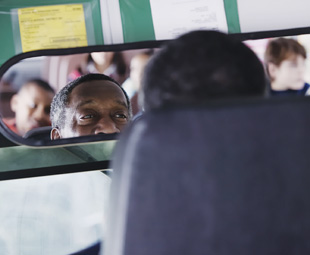Licensed to kill?

If there’s one fact that cannot be disputed when it comes to public transport, it’s this: you are transporting lives. “Owning buses” and “knowing how to drive” just doesn’t cut it. With South Africa’s unenviable record of bus and coach accidents, GAVIN MYERS asks if a lack of training is to blame.
In the year to the end of March 2011, there were 47 799 registered buses on South Africa’s roads – and a staggering 5 745 of them were found to be unroadworthy and unlicensed. This is according to the 2010/11 Road Traffic Report issued by the Road Traffic Management Corporation (RTMC).
Do the maths. It’s 12 percent.
When six of every 50 buses shouldn’t have been on the road and should definitely not have been carrying passengers … that’s an open invitation to tragedy and economic loss
And it implies that 12 of every 100 people who make a living driving buses either don’t care or don’t know how to check the condition of their vehicles – or are working for people who themselves don’t care and fail to take heed of any risks their drivers might report.
The RTMC report also showed that the bus category saw the biggest year-on-year growth, with registrations increasing by 4,23 percent. If this trend continues, are we to expect more untrained and unsafe drivers to hit our roads?
In the same period, there were a total of 838 049 drivers in possession of a professional driving permit (PrDP), 96 percent of them for the passengers and goods category.
Yet another statistic is that 292 buses were involved in fatal crashes countrywide in those 12 months (as an aside, the figures for minibuses and minibus taxis were 1 003 and 405 respectively). In terms of fatalities, 285 people travelling by bus were killed. (Figures for minibus and minibus taxis were comparatively higher at 1 311 and 484 respectively, which would infer that one is at greater risk travelling in a minibus or minibus taxi – but that is a debate for another day.)
Breaking this figure down just one step further reveals that 27 of these fatalities were the drivers themselves, 150 were passengers and pedestrians made up the balance.
It’s clear that it is the drivers themselves, above all others, who are responsible for the lives of their passengers. A variety of factors will influence every road accident, but the fact remains that comprehensive training – of drivers, operators and maintenance staff – is vital.
Speaking at the Southern African Bus Operators Association (SABOA) 2012 Conference in February, Jits Patel, acting chief director for public transportation at the Department of Transport, spoke on the establishment of the National Public Transport Regulator (NPTR) – a requirement of the National Land Transport Act of 2009. Briefly, the NPTR consists of a core regulatory committee set up by the transport minister, and regulates inter-provincial services and tourism transport services at a national level.
“The NPTR as regulatory committee decides on applications for accreditation of transport operators,” says Patel. “This accreditation system is very different to the existing operating license system. The NPTR will actually assess the fitness of the specific person to run public transport, as well as that of his vehicles to transport passengers.”
An important aspect of the system is that of vehicle maintenance. The regulator will track and monitor the service reports of all accredited operators. This will involve regular tactical and operational monitoring to confirm that vehicles are serviced. The regulator will ensure that they are roadworthy, and that the operator has an acceptable maintenance programme.
“With regards to maintenance, it’s expected that big operators will have their own facilities, and that smaller operators will have an arrangement with a legitimate service provider which can be accredited,” says Patel. Accreditation is necessary for maintenance reports to be accepted.
The regulator will also ensure that operators who have their own facilities, and therefore need to have trained mechanics and other technical staff on hand, also have qualified back-up staff and admin facilities.
Patel did not make reference to the regulator’s view on driver training in particular – but the emphasis on properly qualified and trained staff, from the operator to technical and maintenance staff, is reassuring.
According to SABOA executive manager Eric Cornelius, SABOA has an agreement with the Transport Education and Training Authority (TETA) to make funds available for training programmes, such as skills and extended skills programmes for SMMEs, as well as a skills programme for school bus operators.
“SABOA also has a joint venture with the University of Johannesburg, where a number of learners are trained in the Road Passenger Transport Management Programme,” he says, adding that the University also presents a Learnership in Road Transport Management. SABOA had 389 learners trained in these programmes in 2008, and another 330 in 2009.
In support of the enhancement of the industry, SABOA has also applied to TETA for the funding of an SMME programme in critical and scarce skills (such as managing finance, applying basic business principles, conducting fault finding and organising maintenance repairs). Funding for a similar skills programme in tourism, and a new venture creation programme, have both been approved.
What about an operator that does its driver training properly and even offers its services to others? Springbok Atlas is a prime example, and its CEO, Craig Drysdale, embodies the company’s approach: “Driver training is imperative in our business; safety first, make money second is my mantra. Our product offer to our clients is not just a good fleet, but good drivers as well – a sound body and mind if you wish!” he says.
Springbok Atlas offers internal as well as external driver training courses, which are presented by its national driver trainer, Emmanuel Ngesi, and his team of four depot-based driver trainers.
Springbok Atlas requires that drivers have a secondary education and be in possession of both a valid PrDP and the required code driving licence before they will be considered for employment. Obviously, applicants will be at an advantage if they have completed any additional courses or qualifications.
Says Ngesi: “My opinion of a good coach driver is one that is passionate about driving, enjoys working with people, is honest, has a very good personality, obeys all the rules of the road, and, most importantly, takes safety seriously.”
The company has structured its courses around these very qualities and requirements. New recruits are subject to two days of theoretical induction training which covers the Ctrack tracking system and how it works, correct filling in of company documentation, the importance of good customer care and how to handle customer issues, fatigue management, defensive driving techniques, vehicle pre-trip inspections and tyre technology, as well as company code of conduct, profile and policy – and finishes off with a full theory assessment of everything covered.
This is then followed up with practical driver training, where drivers learn practical defensive driving techniques, on-board safety (fire extinguishing, seat belts, and so on), basic technical repairs (such as changing fan belts and tyres), product knowledge in order to understand the different vehicle operations according to manufacturer specification, and customer care by way of role play. This is followed up with a full practical driving assessment.
Importantly, refresher courses are done each year, and the company’s trainers are themselves subject to intensive training courses before conducting the driver training. Just the way it should be.
Published by
Focus on Transport
focusmagsa



